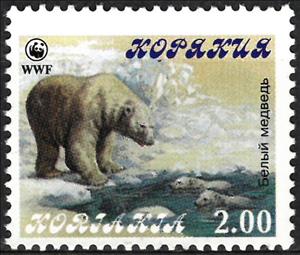Stamp: Polar Bears (Russia, Koriakia 1998)
Polar Bears (Russia, Koriakia 1998)
01 January (Russia, Koriakia ) within release Russia : Koriakia goes into circulation Stamp Polar Bears face value 2 Russian ruble
| Stamp Polar Bears in catalogues | |
|---|---|
| Colnect codes: | Col: RU-KR 1998-09/3 |
Stamp is square format.
This item has been denounced in Russian Federation 2000 UPU Circular 214 and 2002 UPU Circular 15 as illegally produced without the authorization of the postal administration. They have no postal validity.Also in the issue Russia : Koriakia:
- Stamp - Bears face value 2;
- Stamp - Polar Bears face value 2;
- Stamp - Seals face value 2;
|
Data entry completed
53%
|
|
|---|---|
| Stamp Polar Bears in digits | |
| Country: | Russia, Koriakia |
| Date: | 1998-01-01 |
| Print: | Offset lithography |
| Emission: | Illegal |
| Format: | Stamp |
| Face Value: | 2 Russian ruble |
Stamp Polar Bears it reflects the thematic directions:
Animals are multicellular, eukaryotic organisms of the kingdom Animalia (also called Metazoa). All animals are motile, meaning they can move spontaneously and independently, at some point in their lives. Their body plan eventually becomes fixed as they develop, although some undergo a process of metamorphosis later on in their lives. All animals are heterotrophs: they must ingest other organisms or their products for sustenance.
Mammals are any vertebrates within the class Mammalia (/məˈmeɪli.ə/ from Latin mamma "breast"), a clade of endothermic amniotes distinguished from reptiles (including birds) by the possession of a neocortex (a region of the brain), hair, three middle ear bones and mammary glands. All female mammals nurse their young with milk, secreted from the mammary glands. Mammals include the largest animals on the planet, the great whales. The basic body type is a terrestrial quadruped, but some mammals are adapted for life at sea, in the air, in trees, underground or on two legs. The largest group of mammals, the placentals, have a placenta, which enables the feeding of the fetus during gestation. Mammals range in size from the 30–40 mm (1.2–1.6 in) bumblebee bat to the 30-meter (98 ft) blue whale. With the exception of the five species of monotreme (egg-laying mammals), all modern mammals give birth to live young. Most mammals, including the six most species-rich orders, belong to the placental group. The largest orders are the rodents, bats and Soricomorpha (shrews and allies). The next three biggest orders, depending on the biological classification scheme used, are the Primates (apes and monkeys), the Cetartiodactyla (whales and even-toed ungulates), and the Carnivora (cats, dogs, seals, and allies).
The polar bear (Ursus maritimus) is a large bear native to the Arctic and nearby areas. It is closely related to the brown bear, and the two species can interbreed. The polar bear is the largest extant species of bear and land carnivore, with adult males weighing 300–800 kg (660–1,760 lb). The species is sexually dimorphic, as adult females are much smaller. The polar bear is white- or yellowish-furred with black skin and a thick layer of fat. It is more slender than the brown bear, with a narrower skull, longer neck and lower shoulder hump. Its teeth are sharper and more adapted to cutting meat. The paws are large and allow the bear to walk on ice and paddle in the water.


